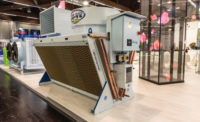Last month’s FROSTlines article looked at how food retailers were rapidly adapting to changes brought about by the pandemic. This included accommodating customers who wanted to place their orders online and either pick them up in person — called click-and-collect — or else have those orders delivered to their homes. In either case, stores had to quickly add refrigerated staging areas that could be used to hold the increasing number of online orders that were being placed.
As the pandemic lingers, changes will continue to affect all parts of the cold chain, from food retailers to distribution warehouses. This will give every part of the grocery sector the opportunity to be innovative and perhaps try new technologies that, to date, they have only thought about implementing.
Cold Storage and Controls
As far as cold storage is concerned, Tony Welter, grocery practice director and vice president at Henderson Engineers in Kansas City, Missouri, predicts that the grocery sector is going to see smaller distribution centers in order to address the “last mile” to a customer’s home. However, there will likely be a variety of cold storage needs coming with mid-size and large distribution centers.
“Henderson has seen an uptick in grocery cold storage projects in the last year,” he said. “Larger cold storage projects can utilize packaged equipment as used in most stores, or they can opt to have a refrigerated plant design. Each client has their own needs when it comes to design, and it is important to present the options and costs in a way an educated decision can be made.”
The grocery industry was definitely experiencing growth in distribution warehouse infrastructures even before the pandemic, agreed Katrina Krites, marketing and business development manager, food retail, cold chain at Emerson, and she expects to see this trend continue to support increases in e-commerce fulfillment activities.
“It’s likely that we will see continuous innovations in click-and-collect as many retailers experiment with various store formats, including dark stores, micro-fulfillment centers, and automated warehouses,” she said. “In many cases, existing stores are not ideally or efficiently laid out to handle large amounts of online orders, and having employees on the sales floor picking to fulfill orders can disrupt the in-store shopper experience. To support this increasing demand, we may see more micro-fulfillment centers and dark stores dedicated exclusively to the fulfillment of online orders.”
As retailers integrate more of these types of facilities into their picking and order consolidation processes, ensuring food safety while maintaining fulfillment efficiencies will become increasingly important, said Krites.

CUSTOMER FOCUS: Grocers are looking to tools and technology to help monitor and control equipment and systems so that employees can stay focused on providing a positive customer experience. Courtesy, Emerson
“This pandemic has brought even more focus for grocers to increase efforts to protect the health and safety of employees, customers, and food,” she said. “As part of this focus, they will look to tools and technology to help them monitor and control equipment and systems so that their employees can stay focused on providing a positive customer experience.”
This means greater demand for critical control systems that can identify key refrigeration and facility performance issues, help ensure that periodic air changes are implemented properly, and help grocers to keep food safe and sanitary. Grocers can also leverage tools and technology to do things like enabling connected, warm hand-washing stations for increased sanitation; installing remote, wireless sensors for food quality monitoring; or providing enhanced HVAC controls to help maintain indoor air quality, said Krites.
“The capabilities to perform remote monitoring, troubleshooting, and problem resolution — including predictive failure and maintenance analysis — are becoming essential resources for retailers hoping to schedule service intervals and minimize disruption to in-store shoppers,” she said.
In these challenging times, big data, automation, and IoT all have the potential to save food retailers time, money, and energy while preventing food waste, said Peter Dee, sales and services director, North America, Danfoss.
“Connected devices, such as refrigeration system controllers, enable remote alarm monitoring to identify and assess threats to the systems, ensuring food safety around the clock while saving substantial service cost and even more costly down time,” he said. “In addition, in-store system managers can collect energy usage and performance data from all connected systems — refrigeration, air conditioning, lighting, and more — enabling food retailers to identify common performance trends among the stores and making incremental improvements across the entire estate.”
Opportunities and Challenges
As grocers adapt to changing consumer shopping habits such as click-and-collect, they will likely be remodeling their stores in order to add refrigeration load. This will give them the prime opportunity to move toward lower-GWP refrigerants, said Krites.
“Many retailers have been considering this transition for quite some time but were uncertain about the exact timing,” she said. “It would make sense to align store design upgrades with their future refrigerant and sustainability objectives. And in certain areas of the country where grocery demand may be leveling out, many retailers will be well-positioned to invest in equipment or store upgrades.”
Glenn Barrett, engineering manager at DC Engineering in Coeur d’Alene, Idaho, agreed, noting that he expects grocers deciding to embark on remodels will likely choose equipment that utilizes natural refrigerants (e.g., propane), or lower-GWP/lower-charge systems.
“I expect CO2 condensing units will also become a new option in the refrigeration designer’s toolkit,” he said. “Not only are they one of the most cost-effective solutions in the low GWP space, they are also modular, which provides a valuable degree of flexibility in store redesign efforts. As end users balance new store layouts and modifications to existing stores with their ongoing work reducing their carbon footprint, I certainly expect the use of more flexible, environmentally friendly refrigeration design components will increase.”
As for challenges, the shortage of refrigeration technicians has been an issue in the grocery store refrigeration industry for years, and technicians becoming sick, along with potential restrictions on site visits, would only exacerbate this issue, said Barrett. That could hinder the ability to keep refrigeration systems operating smoothly, which is why grocers may be interested in new types of equipment and innovative layouts.
“More robust designs and refrigeration system redundancy will become more important the longer the pandemic lingers,” he said. “Systems that are running on the ragged edge during an extracted timeline due to the pandemic may fail, and with COVID-19-related shutdowns, one could envision it becoming more difficult to repair and provide replacement parts, as well as find technicians to make the repairs.”
The good news is that right now, the food chain — which is obviously extremely important to the country — is still intact and functioning at full capacity, said Barrett. But food retailers should not become complacent.
“A few failures at stores that serve vulnerable populations — or are located in ‘food deserts’ — could become catastrophic to the people who live there,” he said. “To offset those risks, food retailers may request more redundancy in their refrigeration system designs, and proactive maintenance would become a valuable improvement to the industry.”
That could be good news for refrigeration contractors and technicians, who — as this pandemic has shown — are absolutely essential in keeping the country’s cold chain running smoothly.






Report Abusive Comment